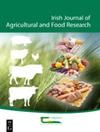Sinapinic and protocatechuic acids found in rapeseed: isolation, characterisation and potential benefits for human health as functional food ingredients
IF 1.4
4区 农林科学
Q3 AGRICULTURE, MULTIDISCIPLINARY
引用次数: 20
Abstract
Abstract Rapeseed is one of the world’s major oilseeds, and rapeseed oil is produced by pressing of the seeds. This process results in the production of a low-economic-value by-product, rapeseed meal, which is commonly used as animal feed. Rapeseed meal is rich in bioactive phenolic compounds, including sinapinic acid (SA) and protocatechuic acid (PCA). Isolation of these bioactive compounds from a by-product of rapeseed oil production is largely in agreement with the current concept of the circular economy and total utilisation of crop harvest using a biorefinery approach. In this review, current information concerning traditional and novel methods to isolate phenolic compounds – including SA and PCA – from rapeseed meal, along with in vitro and in vivo studies concerning the bioactivity of SA and PCA and their associated health effects, is collated. These health effects include anti-inflammatory, anti-cancer, anti-diabetes activities, along with histone deacetylase inhibition and protective cardiovascular, neurological and hepatic effects. The traditional extraction methods include use of solvents and/or enzymes. However, a need for simpler, more efficient methodologies has led to the development of novel extraction processes, including microwave-assisted, ultrasound-assisted, pulsed electric field and high-voltage electrical discharge extraction processes.菜籽中发现的芥子酸和原儿茶酸:作为功能性食品成分的分离、表征和对人类健康的潜在益处
摘要油菜是世界上主要的油料作物之一,菜籽油是通过压榨种子生产的。这一过程产生了一种低经济价值的副产品,菜籽粕,通常用作动物饲料。菜籽粕富含具有生物活性的酚类化合物,包括芥子酸(SA)和原儿茶酸(PCA)。从菜籽油生产的副产品中分离出这些生物活性化合物,在很大程度上符合当前循环经济的概念,并使用生物精炼方法全面利用作物收获。在这篇综述中,整理了从菜籽粕中分离酚类化合物(包括SA和PCA)的传统和新方法的最新信息,以及SA和PCA的生物活性及其相关健康影响的体外和体内研究。这些健康作用包括抗炎、抗癌、抗糖尿病活性,以及组蛋白脱乙酰酶抑制和保护心血管、神经和肝脏的作用。传统的提取方法包括使用溶剂和/或酶。然而,对更简单、更有效的方法的需求导致了新型提取工艺的发展,包括微波辅助、超声辅助、脉冲电场和高压放电提取工艺。
本文章由计算机程序翻译,如有差异,请以英文原文为准。
求助全文
约1分钟内获得全文
求助全文
来源期刊
CiteScore
2.50
自引率
20.00%
发文量
23
审稿时长
>36 weeks
期刊介绍:
The Irish Journal of Agricultural and Food Research is a peer reviewed open access scientific journal published by Teagasc (Agriculture and Food Development Authority, Ireland). Manuscripts on any aspect of research of direct relevance to Irish agriculture and food production, including plant and animal sciences, food science, agri environmental science, soils, engineering, buildings, economics and sociology, will be considered for publication. The work must demonstrate novelty and relevance to the field of research. Papers published or offered for publication elsewhere will not be considered, but the publication of an abstract does not preclude the publication of the full paper in this journal.

 求助内容:
求助内容: 应助结果提醒方式:
应助结果提醒方式:


